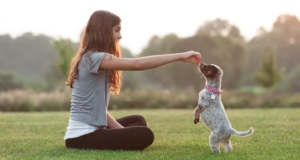Bringing a new puppy into your home is a joyful experience—but it also comes with the responsibility of training. Whether you’ve adopted a rescue pup or brought home a new furry friend, training your puppy at home is essential for a happy, well-behaved dog.
In this guide, we’ll walk you through easy, effective puppy training tips you can start using today—right from the comfort of your home.

✅ Why Home Training is Important for Your Puppy
- Makes socializing and leash training easier
-
Builds a strong bond between you and your pet
-
Helps prevent unwanted behavior (like chewing and barking)
-
Creates a structured, safe environment
📅 When to Start Puppy Training
The best time to start training is as early as 8 weeks old. Puppies are like sponges—they learn quickly and adapt to new routines when introduced early.
🏠 1. Set Up a Safe and Comfortable Training Space
Before you begin, create a consistent training area:
-
Use a crate or dog playpen as their safe zone
-
Avoid high-traffic or noisy areas
-
Keep toys and treats handy
This space should feel secure and calming, where your puppy can focus without distractions.
🍖 2. Use Positive Reinforcement Techniques
Puppies respond best to positive reinforcement:
-
Reward with treats, praise, or toys when they do something right
-
Avoid punishment—it can cause fear or anxiety
-
Be consistent with commands (e.g., “Sit,” “Stay,” “Come”)
💡 Tip: Use short training sessions (5–10 minutes) multiple times a day.
🚽 3. House Training Your Puppy
One of the first and most important lessons is potty training. Here’s how to do it:
Steps:
-
Take your puppy outside every 2 hours
-
Always go to the same spot
-
Reward immediately after they go
Watch for signs: sniffing, circling, or whining could mean they need to go.
🐾 4. Teach Basic Commands
Start with basic obedience commands that build trust and control.
-
Sit – Gently push the pup’s rear down and say “Sit”
-
Stay – Ask your puppy to sit, hold out your hand and say “Stay”
-
Come – Use a leash and call your puppy to you
Repetition and rewards are key. Practice daily!
🐕 5. Socialize Your Puppy Early
Socialization helps your dog grow into a confident, friendly adult. Expose your puppy to:
-
Different people, dogs, and environments
-
Gentle handling by different family members
-
New sounds and sights (cars, bicycles, etc.)
Do this gradually and positively to avoid overwhelming your pet.
🛑 6. Discourage Bad Behavior Gently
Chewing, biting, or barking can be corrected with redirection:
-
Give them chew toys instead of yelling
-
Use firm but calm commands like “No” or “Leave it”
-
Ignore jumping and reward calm behavior
Consistency is more effective than harsh discipline.
🧠 7. Mental Stimulation and Enrichment
Training isn’t just physical—it’s mental too. Use:
-
Puzzle toys
-
New tricks (roll over, paw, etc.)
-
Scent games
Mental stimulation keeps your puppy engaged and reduces boredom-related behavior.
📝 Final Thoughts: Consistency is Key
Training your puppy at home takes time, patience, and love. By creating a routine, using positive reinforcement, and setting clear boundaries, you’re laying the foundation for a well-mannered, happy dog.
Need help with dog adoption or supplies?
At Shellse.com, we’re passionate about supporting responsible pet ownership. From dog rescue stories to pet care tips, we’re here to help you and your furry friend thrive.



